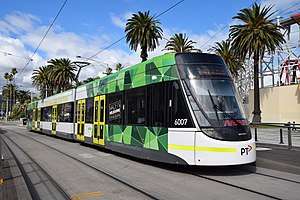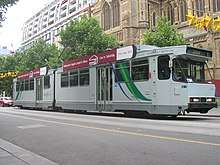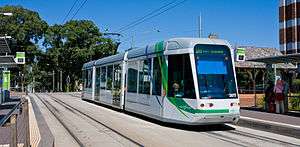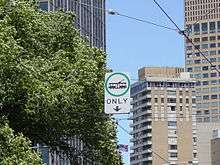Yarra Trams
Yarra Trams is the trading name of the tram network in Melbourne, which is owned by VicTrack and leased to Yarra Trams by Public Transport Victoria on behalf of the Government of Victoria. The current franchise is operated by Keolis Downer. As at May 2014, Yarra Trams operate 487 trams, across 26 tram routes and a free City Circle tourist tram, over 1,763 tram stops. With 250 km (155.3 mi) of double track, Melbourne's tram network is the largest in the world.
 | |
 | |
| Industry | Transportation Company |
|---|---|
| Predecessor | Public Transport Corporation |
| Founded | 1 October 1997 |
| Headquarters | |
Area served | Melbourne |
Key people | Julien Dehornoy (CEO) |
| Parent | TransdevTSL (1999–2004, 2004–2009), Keolis Downer (2009–present) |
| Website | www.yarratrams.com.au |
In 2015/16, 203.8 million journeys were taken on Melbourne's trams,[1] with trams traveling more than 24.8 million kilometres annually. Each week Yarra Trams operates 31,400 scheduled tram services, which results in trams operating for approximately 20 hours per day and a team of 24-hour operations staff completing network maintenance and cleaning.
History


On 1 October 1997 in preparation for privatisation, the Public Transport Corporation's tram operations were split into two business units, Swanston Trams and Yarra Trams.[2][3]
TransdevTSL
MetroLink Victoria Pty Ltd, a joint venture between Transfield Services (50%), Transdev (30%) and Egis (20%), successfully bid to take over the Yarra Trams services from 29 August 1999.[4][5][6][7] Transdev bought out Egis' share in 2000.[8] MetroLink Victoria became part of TransdevTSL in 2007.[9]
The joint venture inherited 23 W, 31 Z3, 28 A1, 42 A2, two B1 and 55 B2 class trams and took over the operation of 10 routes and four depots; Camberwell, East Preston, Kew and Southbank.[10][11] In March 2000 a new white with green and blue stripes and grey skirt livery was introduced.[12]
After National Express (who operated the other half of the network) handed back its M>Tram franchise having been unable to renegotiate financial terms, the State Government temporarily took it over.[13][14][15] In May 2003 the State Government announced it would establish a single company to operate both networks, and was negotiating with TransdevTSL to operate this entity. In February 2004 an agreement was reached, and the networks were reunited on 18 April 2004 under the Yarra Trams brand.[16][17]
Keolis Downer
When the franchise was next tendered, Transdev TSL and Keolis Downer were shortlisted to bid.[18] In June 2009, the franchise was awarded to Keolis Downer with the new franchise commencing on 30 November 2009.[19][20] The Yarra Trams brand was retained.[21] Keolis Downer introduced a new Yarra Trams logo along with a new livery featuring yellow doors.
In September 2017, it was announced that the franchise is to be extended until November 2024, but with tougher conditions.[22][23][24]
Operations
Fleet

As of January 2019, the fleet consists of over 450 W, Z3, A1, B2, C1, C2, D and E class trams, operated from eight depots.[25]
In October 2001, Yarra Trams took delivery of the first of 36 C class Citadis trams which have primarily operated on route 109 to complement the extension to Box Hill.[26][27][28] As part of the acquisition of M>Tram in 2004, Yarra Trams acquired 39 D class Combino trams and oversaw the delivery of another 20 still on order. They are leased from the Commonwealth Bank, rather than VicTrack.[29]
Heritage W-class trams run solely on the City Circle tourist service. Due to these trams being limited to 40 km/h (24.9 mph) as a result of a series of modifications due to braking problems, their use is restricted to ensure limited interference with modern trams.
In 2003, Yarra Trams trialled a seating layout which became known as "Apollo". The trial involved removing 30 seats from a B-class tram and replacing the removed seats with "bum racks" which are found in Citadis trams. This resulted in a higher capacity for standing passengers on crowded services during peak hours. A further ten trams received the seating layout during refurbishment.
Ninety E-class are being delivered by Bombardier Transportation, Dandenong.[30]
Ticketing
Yarra Trams run under the Public Transport Victoria banner, as do other operators of public transport franchises in metropolitan Melbourne, and use the myki ticketing system. Metcard tickets have not been accepted on trams since December 2012, and coin-only Metcard ticket machines and validators have been removed. Seats were installed in place of the ticket machines.
The entire tram network has now changed over to the myki smartcard fare collection system, with passengers needing to buy and top up a valid myki before boarding, or risk a fine of up to $238. Myki cards can be purchased from all staffed railway stations and retail outlets displaying a myki logo, including at all 7-Eleven convenience stores. They cannot be purchased or topped up on board a tram.
All tram routes operate entirely within zone 1. However, routes 75, 86 and 109 enter the zone 1/2 overlap at the very end of their outer-suburban routes. If a passenger begins and ends their journey completely within the zone 1/2 overlap, they can touch off to receive a slightly lower fare. If any part of the journey is within Zone 1, there is no need for the passenger to touch off as the fare is automatically calculated. Touching off on a zone 1 journey is both redundant and may cause delay or inconvenience to other passengers and the tram networks 'on time' performance. If passengers only travel in the free tram zone, there is no need to touch on their myki.
Network expansion

Since privatisation, the tram network has grown in size as a result of a number of extensions. The accessibility of the network has also been improved, with 360 platform stops built as of January 2014.[31]
In March 2000 services were extended to the new Melbourne Docklands precinct. Since then, a line connecting La Trobe and Flinders Streets via Docklands has been constructed as well as a further extension along Docklands Drive to NewQuay, which opened in January 2005. route 109 was extended 2.2 km (1.4 mi) from Mont Albert to Box Hill in May 2003. The extension to Box Hill has provided a direct link between Box Hill and suburbs such as Balwyn, Kew and Richmond.
In July 2005, a 3 km (1.9 mi) extension of route 75 from Burwood East to Vermont South opened.
In April 2018, the state government announced a new extension of the tram network from Caulfield.[32] The 18 km (11.1 mi) extension would serve Chadstone, Monash University, Waverley Park and Rowville.[33] The state government allocated $3 million to plan the route, which would be carried out in two stages.[34]
Think Tram

Yarra Trams is a partner in the Think Tram program with VicRoads, aimed at improving tram travel time and reliability. In conjunction with the Victorian government several initiatives are in place to enable trams to better meet punctuality targets. These include 'T-lights' which give trams priority at traffic signals, as well as part-time tram lanes and full-time tram lanes.
Part-time tram lanes are used often only during peak hours, with an example of this being on High Street along the route 6. Vehicles must not enter a part-time tram lane at any point during the nominated times except to avoid an obstruction, or perform a right turn; even then, vehicles must not proceed by law into the lane to do so unless they will not delay any approaching tram/s from either direction. The limit for staying in the lane to avoid an obstruction or turn right is 50 metres, at which point a vehicle must exit the lane entirely.
Full-time tram lanes often utilise raised curb dividers to physically prevent cars from straying onto tram tracks. Examples of these dividers can be seen on Spencer Street, Swanston Street in Carlton and Fitzroy Street in St Kilda. Vehicles must not enter a full-time tram lane at any time except to avoid an obstruction; even then, vehicles must not proceed by law into the lane to do so unless they will not delay any approaching tram/s from either direction. The limit for staying in the lane to avoid an obstruction is 50 metres, at which point a vehicle must exit the lane entirely. Some lanes only allow this to occur at certain points, or breaks, in the raised dividers. Crossing the raised dividers otherwise can cause severe damage to a vehicle.
Beware the Rhino

In May 2011, Yarra Trams launched their 'Beware The Rhino' safety campaign, aiming to increase awareness of tram traffic. It analogises a stampede of rhinoceroses as being as dangerous as a tram, highlighting the dangers that people put themselves in when they move into the path of a tram.[35] The campaign has won creativity awards,[36] and was refocused in 2013.[37]
Legislation and governance
Transport Integration Act
The prime transport-related statute in Victoria is the Transport Integration Act 2010, which establishes the Department of Transport as the integration agency for Victoria's transport system. The Act also establishes and sets the charters of the state agencies charged with providing public transport rail services, namely the Public Transport Development Authority. The PTDA is empowered by the Transport Integration Act to contract transport operators to provide rail and bus services and has used those powers to contract Yarra Trams to provide tram services in Melbourne.[38]
In addition, the Transport Integration Act establishes VicTrack which owns the public rail network and associated infrastructure. Another important statute is the Rail Management Act 1996[39] which confers powers on rail operators and provides for an access scheme for the state's rail network. The Transport (Compliance and Miscellaneous Act) 1983 is also a relevant statute relating to public transport and contains a number of offences relating to safety, ticketing and amenity.
Rail Safety Act
The safety of rail transport operations in Melbourne is regulated by the Rail Safety Act 2006 which applies to all commercial passenger operations.[40] The Act establishes a framework containing safety duties for all rail industry participants and requires operators who manage infrastructure and rolling stock to obtain accreditation prior to commencing operations. Accredited operators are also required to have a safety management system to guide their operations. Sanctions applying to the safety scheme established under the Rail Safety Act are contained in the Transport (Compliance and Miscellaneous) Act 1983.[41] The safety regulator for the rail system in Melbourne including trams is the Director, Transport Safety (trading as Transport Safety Victoria) whose office is established under the Transport Integration Act 2010.
Incidents/Accidents
On 6th of October, 2019, a C-Class Tram was involved in an accident, causing it to de-rail. The incident occurred at approximately 11:30am, where a white Hyundai SUV tried to pass the tram on the 109 Route at Cotham St, Kew. As it tried to pass, the SUV attempted to fit through the tram and a parked vehicle. Unable to pass, or stop, it crashed into the stationary vehicle, before colliding with the tram, causing it to de-rail and crash through a residential fence and garden. 19 people on the tram were injured, as were the two occupants in the SUV. The road was reopened later the day at 4:15pm, after an extensive clean-up. [42]
References
- "Network statistics". Public Transport Victoria. Archived from the original on 30 September 2017. Retrieved 23 March 2017.
- "City in Brief" Railway Gazette International December 1997 page 835
- "Melbourne on the brink of change" Trolley Wire issue 273 May 1998 page 3
- "First Melbourne franchise" Railway Gazette International July 1999
- "NEG conquers Oz" Rail Magazine issue 363 11 August 1999 page 11
- "Trams in Melbourne". Yarra Trams. Archived from the original on 27 September 2016. Retrieved 25 June 2013.
- Transfield Services (19 February 2004). "Transfield Services/Transdev Partnership With the State Government of Victoria to Operate the Entire Melbourne Tram Network" (PDF) (Press release). Australian Securities Exchange. Retrieved 25 June 2013.
- Melbourne Yarra Trams Egis Australia
- "Sustainability drives TransdevTSL". Transfield Services. 2008. Archived from the original on 22 February 2014. Retrieved 4 June 2013.
- "Prelude to Privatisation - New Rail & Tram Capital Works for Melbourne" Railway Digest January 1999 page 13
- "Yarra Trams" Trolley Wire issue 279 November 1999 page 25
- "Melbourne - Yarra Trams" Trolley Wire issue 281 May 2000 page 30
- National Express walks out of Australian rail service The Daily Telegraph (London) 17 December 2002
- Receivers take over train, tram group The Age 24 December 2002
- Nat Express pull back Down Under The Daily Telegraph (London) 3 September 2004
- "Yarra Trams takes over" Railway Gazette International May 2004 page 254
- "Yarra Trams takes over in Melbourne" Trolley Wire issue 297 May 2004 pages 21/22
- "Two from three shortlisted" Railway Gazette International September 2008 page 566
- "Melbourne operators selected" Railway Gazette International August 2009 page 12
- Cooper, Mex (25 June 2009). "New train, tram operators for Melbourne". The Age. Retrieved 25 June 2013.
- Gardiner, Ashley (2 September 2009). "New operators promise a smoother ride in time for summer". Herald Sun. Retrieved 25 June 2013.
- Full steam ahead: Government offers Metro and Yarra Tram seven more years The Age 29 September 2016
- Keolis Downer retains contract to operate world's largest tram network Metro Report International 12 September 2017
- Tough new conditions, fines for Metro Trains and Yarra Trams
- "Facts & figures". Yarra Trams. Archived from the original on 29 May 2014. Retrieved 25 June 2013.
- Alstom to supply new trams and maintenance for Melbourne Alstom 6 October 2000
- "Yarra Trams Orders Alstom's Citadis Cars" Railway Digest December 2000 page 15
- Low floor trams have arrived Archived 29 October 2013 at the Wayback Machine Yarra Trams 17 August 2001
- Rattlers one day, combino the next The Age 24 November 2002
- Carey, Adam; Butt, Craig (19 June 2013). "Tram squeeze eases but some still suffer". The Age. Retrieved 25 June 2013.
- "Accessible trams". Public Transport Victoria. Retrieved 16 January 2014.
- "New Tram To Connect City's South-East". Premier of Victoria. 10 April 2018. Retrieved 4 January 2019.
- "Government plans new tram route for Melbourne's south-east". ABC News. 10 April 2018. Retrieved 4 January 2019.
- "Government plans new tram route for Melbourne's south-east". ABC News. 10 April 2018. Retrieved 4 January 2019.
- "Positive results following Beware The Rhino campaign". Yarra Trams. Retrieved 25 June 2013.
- "Rhino is named Australia's best". Yarra Trams. Archived from the original on 19 July 2013. Retrieved 25 June 2013.
- "Drivers beware – The rhino returns with a new safety message". Yarra Trams. Archived from the original on 1 June 2013. Retrieved 25 June 2013.
- Transport Integration Act 2010], section 68(2)(b).
- "Rail Management Act 1996" (PDF).
- "Rail Safety Act 2006" (PDF). Parliament of Victoria. Retrieved 16 January 2014.
- "Transport (Compliance and Miscellaneous) Act 1983" (PDF). Parliament of Victoria. pp. 267–455 (part 7). Retrieved 16 January 2014.
- "Tram derails after colliding with car, ploughs through fence in Kew". The Age. 6 October 2019. Retrieved 6 October 2019.
External links
| Preceded by Public Transport Corporation |
Trams in Melbourne (East/west CBD routes) 1999–2009 |
Succeeded by Incumbent |
| Preceded by M>Tram |
Trams in Melbourne (North/south CBD routes) 2004–2009 |
.jpg)